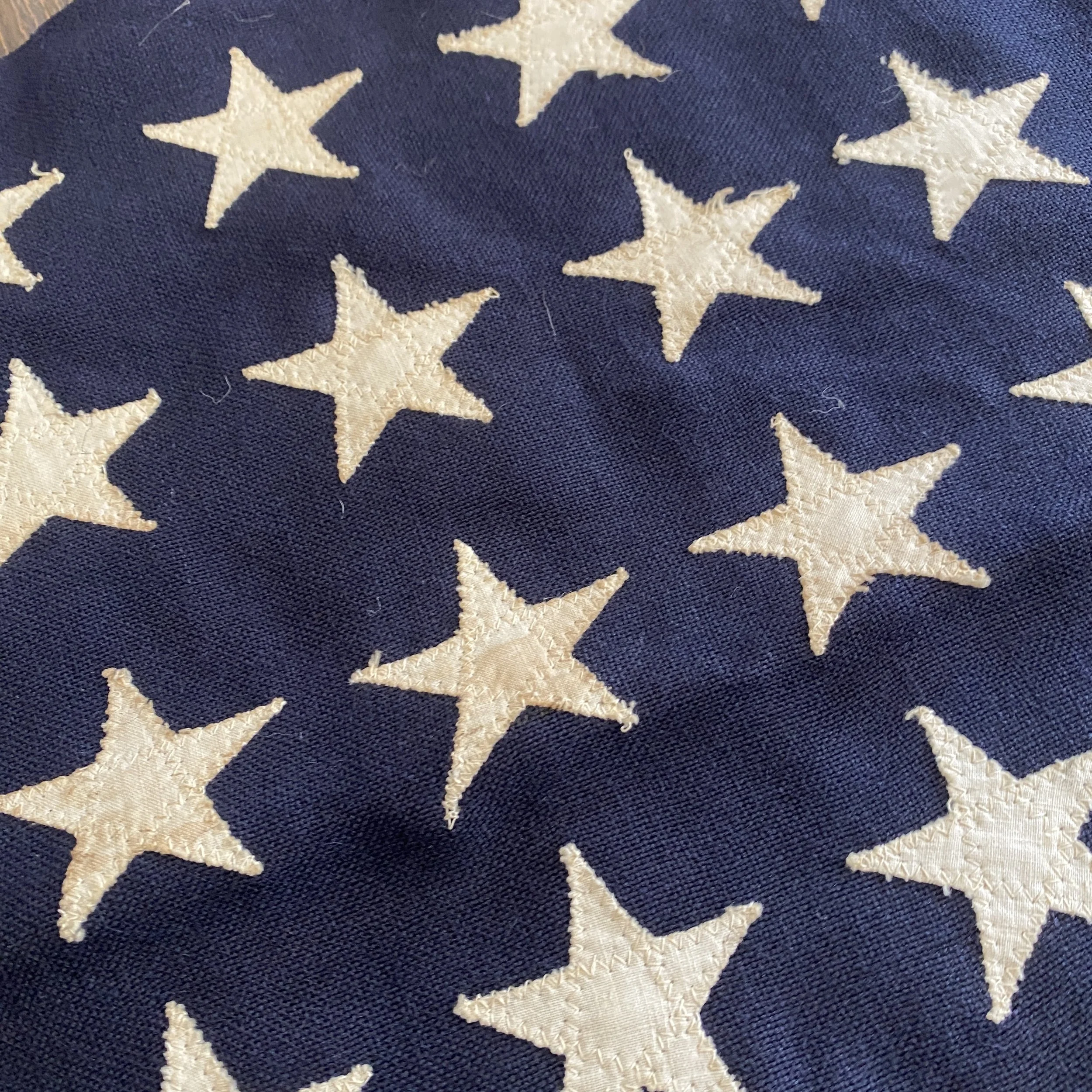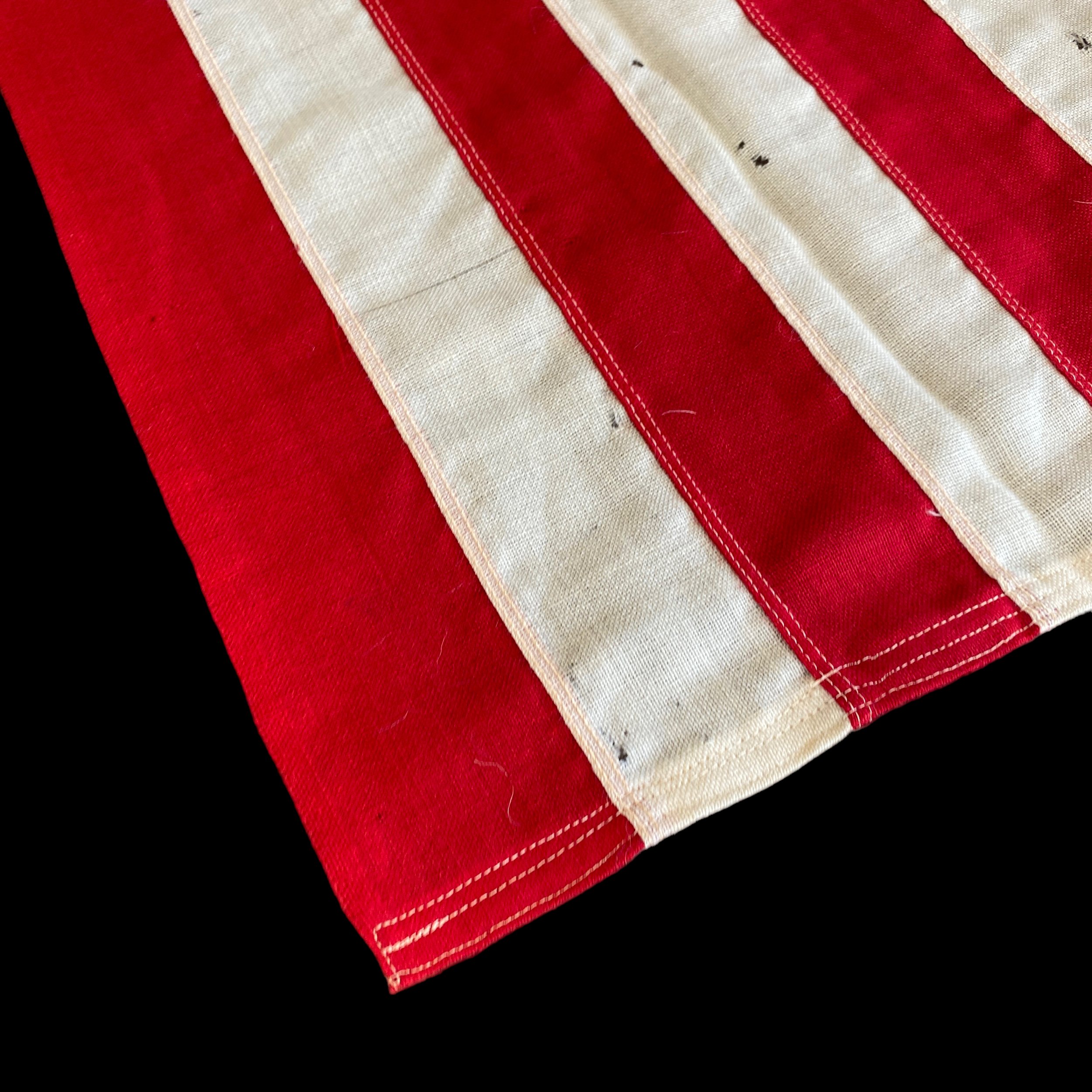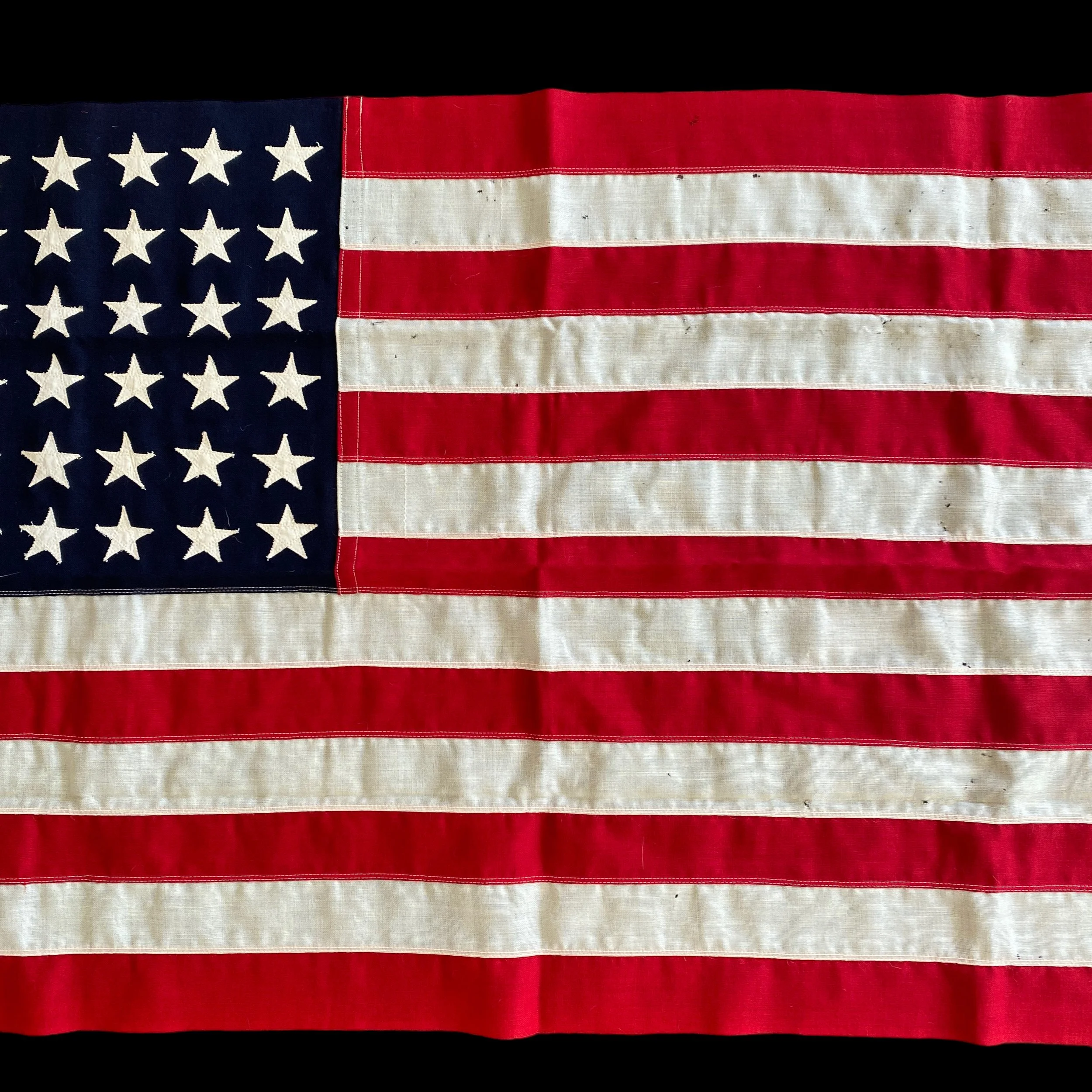RARE! WWII United States Navy Ensign No. 11 "Theater-Flown" 48 Star U.S.N. Flag*






















RARE! WWII United States Navy Ensign No. 11 "Theater-Flown" 48 Star U.S.N. Flag*
Comes with hand-signed C.O.A.
This incredible World War II ‘salty’ four grommet theater flown U.S. Navy flag shows good theater use and wear. Only small handfuls of heavily used NO. 11 landing ship flags have come to market as most are displayed in museums. The NO. 11 type flag type is historically documented as being issued and flown on small landing crafts including LCI (Landing Craft Infantry). The NO. 11 marked flag is one of the most sought-after number (No.) marks by collectors. This U.S.N. No. 11 flag still clearly shows the original “U.S. ENSIGN 11” ink stamp, however, the marker mark stamp Mare Island (MI), or Valley Forge mark is completely faded due to the salty ocean and sun. This flag is the exact U.S. ENS NO. 11 flag type that amphibious all WWII landing crafts, LCI, LCT’s, etc. stormed the beaches of Normandy, Italy, Okinawa, Africa, Iwo Jima, etc. with as well as other beachheads in both the ETO and PTO.
This flag is from the same production line of some of the most famous flags seen in some of the most high-end and famous museums including: The World War II American Flag flown on LCT 595, one of the first craft to land at Normandy on June 6, 1944, Ensign Flown from LCI(L)-488 on D-Day at Omaha Beach Landing, LCT 530 (Landing Ship Tank) Took in the Utah beach amphibious landings in the Normandy invasion. It is believed this flag is from the 1943 or 1944 production year and comes from either the Valley Forge war production line or Mare Island war production line. Both were some of the most famous and notable flag makers for the military during WWII. The Mare Island Naval Station in San Francisco Bay was home to what was known as the Pacific Fleet, however, their flags were used throughout all theaters war during WWII. Mare Island’s is highly recognized for providing flags for all of the amphibious assault craft and ships in 1944 for the Normandy landings which were the landing operations and associated airborne operations on Tuesday, 6 June 1944 of the Allied invasion of Normandy in Operation Overlord during World War II. Codenamed Operation Neptune and often referred to as D-Day, it was the largest seaborne invasion in history. The operation began the liberation of France (and later western Europe) and laid the foundations of the Allied victory on the Western Front. These WWII ensign theater flags were usually taken down and kept by a Navy sailors and GI’s because it was flown during a major battle and operation or the ship was being damage repaired in a dock and they were kept as war souvenirs. Used landing craft flags from WWII were a very sought after war prizes as talked about by many WWII veterans.
World War II stands as one of the most defining periods in human history, reshaping global politics, economies, and societies. Central to this monumental conflict was the role of the United States Navy (U.S.N.), which played an indispensable role in both the European and Pacific Theaters of the war. At the heart of the U.S. Navy's identity and representation was the ensign flag, a symbol of national pride, unity, and determination. This essay delves into the significance of the WWII U.S. Navy ensign flag and its application in the context of the European and Pacific Theaters.
The ensign flag of the U.S. Navy, holds deep symbolism that reflects the nation's values, history, and commitment to freedom. Its field of stars and stripes embodies the unity of the states, while the blue canton with fifty white stars symbolizes the nation's endurance and its constellation of aspirations. The red and white stripes represent valor and purity, respectively, qualities that the U.S. Navy exemplified as it engaged in the arduous battles of WWII.
This ensign flag held enormous significance not only for those serving in the U.S. Navy but also for the American public and the global community. It served as a tangible representation of American resolve, honor, and resilience, a banner under which sailors and citizens alike rallied to protect democracy and combat tyranny. The flag's presence on naval vessels signaled the United States' unwavering commitment to freedom and its determination to defend it at any cost.
In the European Theater of WWII, the U.S. Navy's ensign flag was a steadfast symbol of solidarity with Allied forces. While the primary naval theater of war was the Pacific, the U.S. Navy's contribution in the Atlantic was crucial. Naval convoys transported troops, equipment, and supplies across the treacherous Atlantic Ocean to support Allied campaigns against Nazi Germany. The ensign flag was a beacon of hope for these convoys, reminding sailors and soldiers of the shared purpose they fought for.
The D-Day landings in Normandy, France, marked a pivotal moment in the European Theater. The U.S. Navy played a pivotal role in the amphibious assault, providing naval gunfire support and safeguarding the vast armada of ships involved. The ensign flag fluttered atop battleships, cruisers, and destroyers as they unleashed their firepower against German defenses, and its presence uplifted the spirits of the men who stormed the beaches.
The Pacific Theater saw the U.S. Navy's ensign flag unfurling in all its glory, as the conflict with Japan was predominantly a naval and amphibious war. From the outset of the war, the Japanese Empire's expansion and aggression threatened the United States' interests in the Pacific. The bombing of Pearl Harbor in 1941 marked a turning point, propelling the U.S. into a war it could not ignore.
The ensign flag flew triumphantly during major battles in the Pacific, such as the Battle of Midway and the Battle of Guadalcanal. Naval carriers, destroyers, and submarines played a critical role in these engagements, leveraging their mobility and firepower to secure strategic victories. The flag served as a symbol of unity among the diverse U.S. Navy forces, from aviators to submariners, who collaborated to gain the upper hand against a formidable foe.
The iconic image of the U.S. Marines raising the flag on Iwo Jima's Mount Suribachi encapsulates the ensign flag's significance in the Pacific Theater. The flag-raising represented not only a territorial victory but also a broader triumph of American determination and sacrifice in the face of fierce resistance.
The WWII U.S. Navy ensign flag was more than just a piece of cloth; it was a potent symbol of America's resolve, sacrifice, and dedication to freedom. In both the European and Pacific Theaters, it served as a guiding light for sailors, soldiers, and citizens alike. The flag's presence on naval vessels and battlefields resonated with the nation's principles, representing unity, courage, and a commitment to preserving democratic values. As we reflect on the monumental impact of World War II, we must recognize the ensign flag's role in uniting a nation and rallying it to achieve extraordinary feats in the name of peace and liberty.